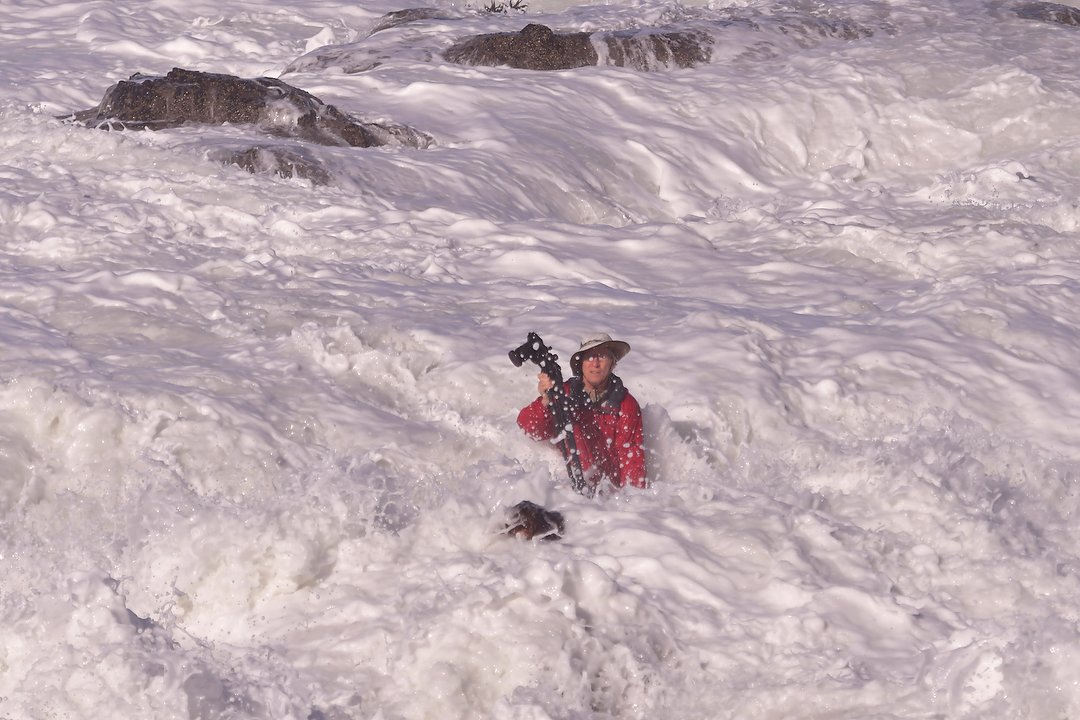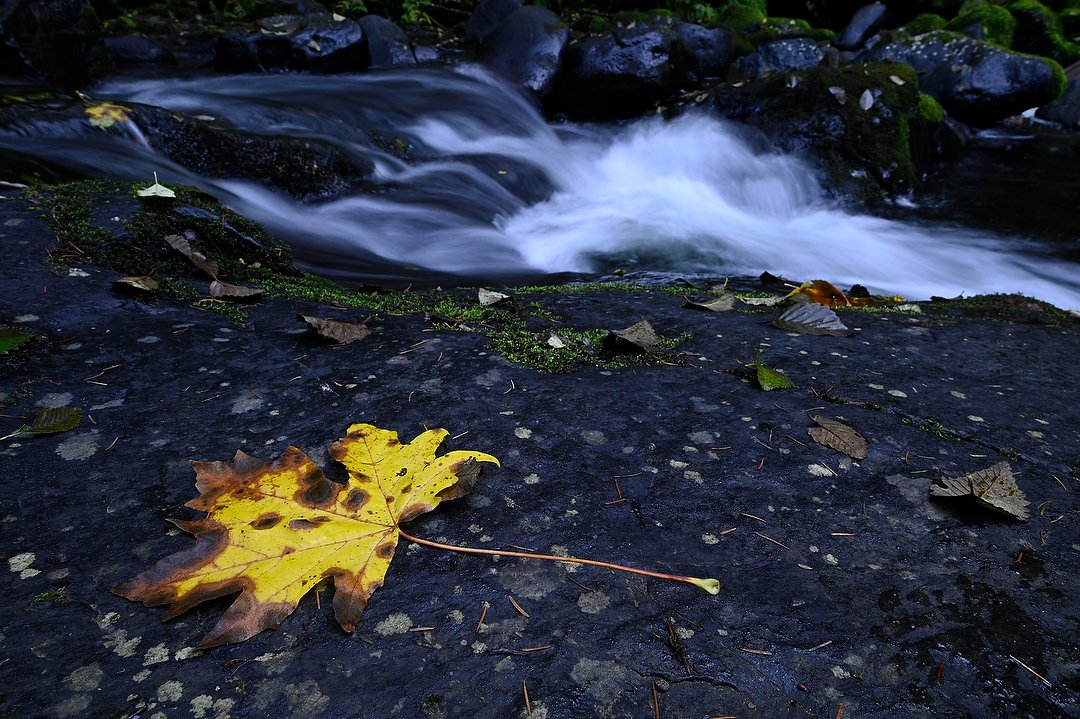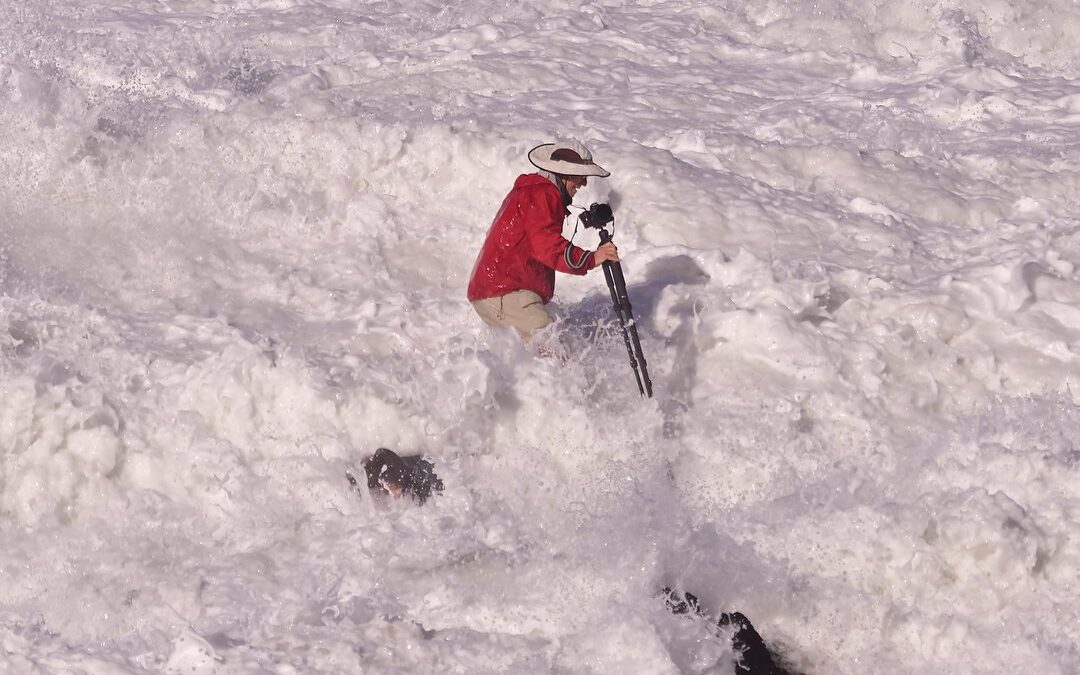No digital SLR I know of is waterproof, but I can definitely tell you the Nikon Z 6 is very well sealed against water, as well as the Nikkor 14-30mm f/4 Z lens. How I know that is not something I’d recommend anyone else try!
Two weeks ago I was leading the first of two workshops along the central Oregon coast. Near the end of the trip, we visited one of Oregon’s iconic locations, Thor’s Well. To make the classic photo of it means wading into surf. I’d led a trip there before, six years ago, and after seeing waves crash through, decided it wasn’t worth the risk. This time, however, after watching for about five minutes and seeing that the highest surf in the area around it was about ankle deep, two of us decided to give it a try. Emptying our pockets of phones and taking one camera, one lens and a tripod, we ventured out. For the first ten minutes, we shot photos and had some waves wash across our feet, but nothing more. Then that changed.

I made this photo four minutes before the big wave hit us, venturing closer to Thor’s Well for a better angle. After shooting a few frames, I moved back up onto the raised ledge we were standing on to avoid most of the surf. Nikon Z 6, Manual exposure, Natural Auto white balance, ISO 250, 1 second at f/8 using a ten-stop neutral density filter, Nikkor Z 14-30mm f/4 S lens at 30mm.
Anyone who spends time along the coast should be familiar with the term “sneaker wave.” Every now and then one wave will come along larger than the rest, reaching higher and further. It can “sneak” up on you. That’s exactly what happened to us. We saw it coming and braced, but it was at least waist-high, tossing the other photographer off the ledge into the water and knocking me down. I got soaked, my camera got drenched, and she and her camera went under. As the water receded I got up and helped her up, then we retreated away from the water. Both of us had our legs scratched up by the lava rock, and she hit her knee as well. Someone nearby offered us a liter of water, and after she drank some, I poured the rest of it over both of our cameras (to try to lessen the effects of the saltwater). As we got back to dry land, a member of our group brought a few bottles of water to us, and I poured more of that over both cameras and lenses. I didn’t have much faith that her gear might survive, since it had been submerged. But mine, while very wet, had not gone under. I had hope, because I knew of a similar story with that model of Nikon camera.

Tim Brennan, part of my group, was on the overlook above watching when the “sneaker” wave got us, and shot a series of photos. This is when I was pushed off the ledge. The other photographer was knocked off the ledge and went under – you can just see part of her in the water in front of me. Her camera and lens went completely under. You can also see Thor’s Well draining behind us.
Soon after the Nikon Z 6 came out, a friend told me how he’d dropped his into a stream while crossing. It had gone completely under, with the lens attached, but he pulled it out immediately. Drying it off as best he could immediately, after returning home he took the lens off, opened all the compartments and gave it a couple of days to dry. To his great surprise, after that, both the body and lens worked fine. So I did the same thing. Knowing a wet camera and electricity aren’t a good combination, I turned my camera off immediately after getting up from the surf. Second step, as I already mentioned, was giving it a good dousing with water, to minimize any damage from the salt. And then, after we returned to our hotel to clean up, I wiped it all down, took the lens off, removed the battery and opened the card door. My first bit of good news was that I saw no water anywhere inside. After that I left the body and lens in my room to dry for the next 24 hrs. The next day I put it all back together, crossed my fingers and turned it on. Miraculously, both worked fine and I’ve been using it ever since. Unfortunately, her camera didn’t survive, although her SD card did, so at least she got a nice photo from the misadventure.

The next day we visited Sweet Creek Falls, and I shot this photo with that same kit – Nikon Z 6 and 14-30mm lens – which were working just fine by then. Nikon Z 6, Manual exposure, Natural Auto white balance, ISO 100, 1/2 second at f/14, Nikkor Z 14-30mm f/4 S lens at 20mm.
The following week I was back at Thor’s Well once more with my second group (and my experience from the week before). We watched waves wash across that same area, only larger and more regularly. And guess what? We had the good sense not to go in!
I do plan to return to the Oregon coast to lead more photo trips, and we’ll visit Thor’s Well again too. But in spite of what I now know about Nikon’s weather sealing, I hope to never put my gear to the test like that again. A gentle rain is all the water I ever want to expose it (and me!) to from now on.
(If you like this story, please share it with your friends and let them know about the links on photography that I post on my business Facebook page. I’m also on Instagram and Twitter, @reedhoffmann. And if you’re curious about the workshops I teach, you can find them here. And, you can subscribe to this blog on my home page.)


A few years ago I was on the island of Oahu and had stopped at Halona Beach Cove, this is the famous beach where a scene from the movie, From Here To Eternity was filmed in 1953 and many in many more film since. Tourists from some busses were standing on the rocky ledge with their backs to the ocean and waves were breaking behind them and creating a soft mist falling on them.
The bus driver was watching, he was a native Hawaiian and we talked a bit. He looked at the people there and remarked, “We natives know never to turn your back on the ocean, I gave them a warning but they didn’t listen.” Sure enough a moment later a huge wave broke and knocked a couple of them down but luckily did not knock them off the rocky ledge.
Glad no one was hurt, but that was a good lesson, right Chris?
Great Story, Reed. I know that I’m not adventurous enough (or limber enough) to do that, so glad you both could do it without serious injury. I hope she had another camera to use!
Yes, she had a friend along with a spare body, and we only had one day left. And, she made lemonade out of lemons to buy a replacement camera that better fit what she likes to do.
amazing
Hi Reed,
Wow! A Good & Cautionary story! ‘Glad that you & the other photographer were ok 👍. This has to be one for a Nikon newsletter.